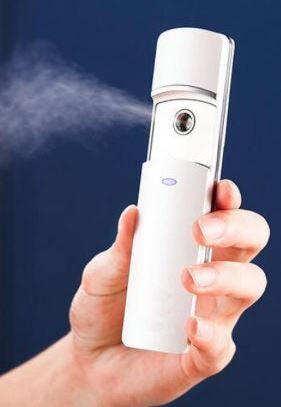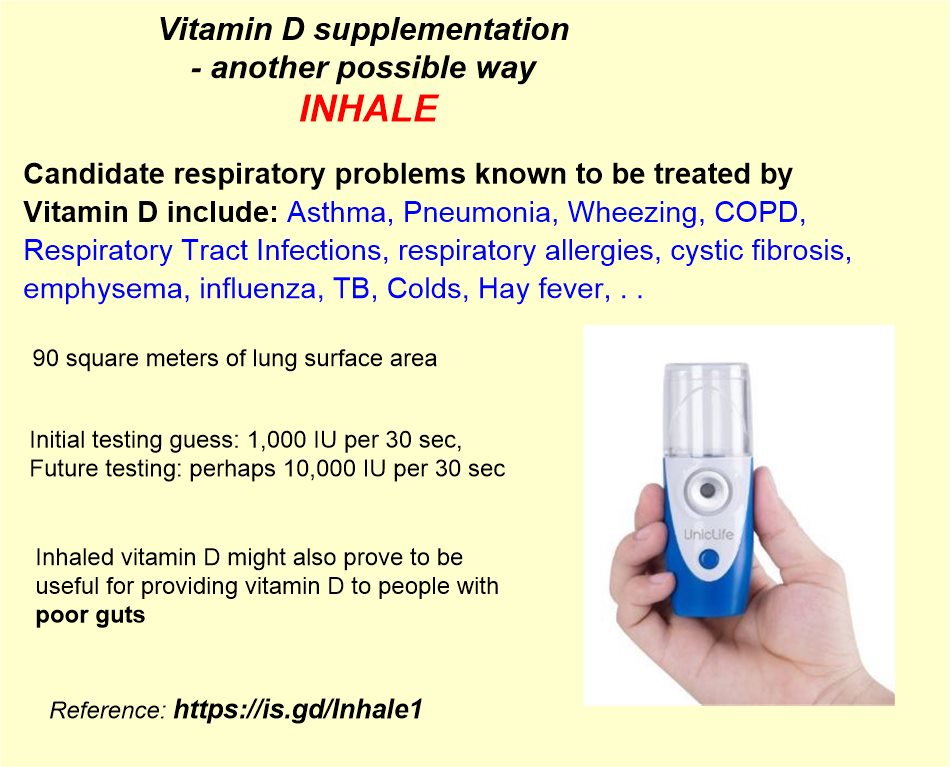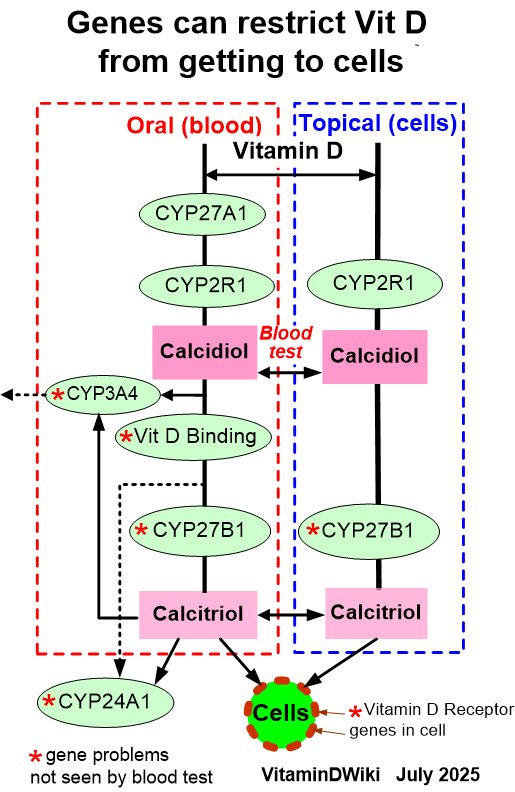Inhaled vitamin D help lungs - many studies
Inhaled Vitamin D has treated my breathing problems from pollen, forest fire smoke, mold, dust, and my exercise-induced asthma for 8 years now.
It might also help with other breathing problems proven to be helped by oral Vitamin D:
The benefits of 5 seconds of inhaled vitamin D are felt in less than 2 minutes.
- The volume of air inhaled increased by 4 times: 500 ml to 2000 ml as measured by a spirometer $40
Amazingly, only about 500 IUs of inhaled Vitamin D are needed.
Since using inhaled Vitamin D, I only use an Albuterol inhaler a few times per year.
- I had been using Albuterol about 10 times per month.
5 years ago I experimented with 10 inhalers and 5 nanoemulsions - most worked.
- I ended up using Vitamin D Nurasal nanoemulsion $22 and Facial Steamer $7.
I just add 1 part Vitamin D nanoemulsion to 3 parts 0.9% saline solution (add 4.3 grams of salt to 1 pint of distilled water).
I keep the inhaler and extra liquid in the refrigerator to stop mold from otherwise growing in about 2 months.
Every 4-6 months I rinse the inhaler with tap water and make a tapwater mist for 30 seconds.
I infrequently wear a $40 mask with a battery powered HEPA filter to clean very dirty air when exercising outdoors.
Founder of VitaminDWiki- Dec 2024
 New version in 2017 own 10 inhalers as of June 2019 them in 2018
New version in 2017 own 10 inhalers as of June 2019 them in 2018
 It might be possible to just put some water-soluble vitamin D powder into water in an atomizer
A Vitamin D inhaler/atomizer/nebulizer might be very useful for some kinds of respiratory problems -such as
Asthma, Pneumonia, Wheezing, COPD, Respiratory Tract Infections, respiratory allergies, second-hand smoke, . .
3 million molecules of Vitamin D per alveoli (500 million alveoli in lungs, 1.5 trillion molecules in 40 IU of Vit D)
It might be possible to just put some water-soluble vitamin D powder into water in an atomizer
A Vitamin D inhaler/atomizer/nebulizer might be very useful for some kinds of respiratory problems -such as
Asthma, Pneumonia, Wheezing, COPD, Respiratory Tract Infections, respiratory allergies, second-hand smoke, . .
3 million molecules of Vitamin D per alveoli (500 million alveoli in lungs, 1.5 trillion molecules in 40 IU of Vit D)
 Update Nov 2016: Inhaled Vitamin D water with purchased nebulizer - lungs feel much better in < 1/2 hour.
Dec 4: Continue to use it daily. I inhale about 500 IU of vitamin D in 30 seconds
Powder of 50,000 IU Vitamin D capsule dissolved in 5 tablespoons of water
Pour off or filter the water thru a coffee filter so as to keep the cellulose from clogging the inhaler
Update 2018 - switched to using Vitamin D Emulsion
2 parts water to 1 part Vitamin D emulsion ==> inhaler
1 of the sources of Vitamin D emulsion Amazon
Update 2019: >10 companies making nebulizers and >10 companies making Vitamin D emulsions
Bought several more nebulizers on Amazon Aug 2020 1 2 3 4
Update April 2025: 2 Misters costs a total of $10 Amazon
Update Nov 2016: Inhaled Vitamin D water with purchased nebulizer - lungs feel much better in < 1/2 hour.
Dec 4: Continue to use it daily. I inhale about 500 IU of vitamin D in 30 seconds
Powder of 50,000 IU Vitamin D capsule dissolved in 5 tablespoons of water
Pour off or filter the water thru a coffee filter so as to keep the cellulose from clogging the inhaler
Update 2018 - switched to using Vitamin D Emulsion
2 parts water to 1 part Vitamin D emulsion ==> inhaler
1 of the sources of Vitamin D emulsion Amazon
Update 2019: >10 companies making nebulizers and >10 companies making Vitamin D emulsions
Bought several more nebulizers on Amazon Aug 2020 1 2 3 4
Update April 2025: 2 Misters costs a total of $10 Amazon
 Surface area of lungs + nose =8X more than the small intestines
| | |
| --- | --- |
| | square meters |
| Respiratory | 90 |
| Nasal passages which include microvilli | 160 |
| Small Intestines - where oral Vitamin D is absorbed | 30 |
1. See also VitaminDWiki
* COPD reduced by 40 percent with monthly 100,000 IU of vitamin D – RCT Jan 2015
* Wonder how many days it would take to reduce Asthma or COPD if Vitamin D were inhaled?
* Update 2019: A person with severe COPD really liked inhaling Vitamin D
* Inhaled Vitamin D 1 page summary March 2019
* Inhaling Vitamin D nanoemulsion through nose gets lots more to the brain (mice) – July 2020
* Perhaps drugs such as inhaled vitamin D can get directly to the brain – March 2018
* Largest cause of infant deaths is respiratory infections, which is associated with low vitamin D – April 2011
* Antimicrobial implications of vitamin D – Oct 2011
* Respiratory infections (RTI) cut in half by 20,000 IU weekly vitamin D if initially deficient – RCT March 2015
* Overview Asthma and Vitamin D
* Childhood asthma still reduced 4 months after 800 IU of Vitamin D daily - RCT Feb 2016
* Inhaled vitamin D helped lungs of new-born (rats) – Dec 2016
* This is the paper which got me thinking about inhaled vitamin D
* Lung cells activate Vitamin D, without liver or kidney – Nov 2016
* Vitamin D sprayed inside cheeks (buccal spray) - several studies
* Topical vitamin D might be more bio-available than oral – Oct 2015
See also VitaminDWiki - activation outside of the lungs, liver-kidneys
* Vaginal Vitamin D reduced vaginal infections - Jan 2014 another local application
* Malignant melanoma may be reduced by skin-activated vitamin D – Nov 2016
* The eyes can also activate vitamin D – Feb 2014
* PhD Dissertation - Local production of active vitamin D inhibits Prostate Cancer – Oct 2012
* Kidney not essential for Vitamin D3 activation – fungi can do it – Jan 2014
* Bones can activate vitamin D – July 2013
* Mitochondria Vitamin D interaction – many studies
* Eczema (Atopic Dermatitis) treated by 1600 IU of vitamin D – meta-analysis Dec 2016
* Itchy skin (pruritus) due to kidney disease was treated with topical vitamin D – April 2015
* Topical Vitamin D
Emulsions on VitaminDWiki
* Nanoemulsion Vitamin D may be a substantially better form
---
1. Breathing category starts with the following
{include}
---
1. Vitamin D can be converted to an activated form in most cell tissues; no gut, liver, or kidney are needed
Surface area of lungs + nose =8X more than the small intestines
| | |
| --- | --- |
| | square meters |
| Respiratory | 90 |
| Nasal passages which include microvilli | 160 |
| Small Intestines - where oral Vitamin D is absorbed | 30 |
1. See also VitaminDWiki
* COPD reduced by 40 percent with monthly 100,000 IU of vitamin D – RCT Jan 2015
* Wonder how many days it would take to reduce Asthma or COPD if Vitamin D were inhaled?
* Update 2019: A person with severe COPD really liked inhaling Vitamin D
* Inhaled Vitamin D 1 page summary March 2019
* Inhaling Vitamin D nanoemulsion through nose gets lots more to the brain (mice) – July 2020
* Perhaps drugs such as inhaled vitamin D can get directly to the brain – March 2018
* Largest cause of infant deaths is respiratory infections, which is associated with low vitamin D – April 2011
* Antimicrobial implications of vitamin D – Oct 2011
* Respiratory infections (RTI) cut in half by 20,000 IU weekly vitamin D if initially deficient – RCT March 2015
* Overview Asthma and Vitamin D
* Childhood asthma still reduced 4 months after 800 IU of Vitamin D daily - RCT Feb 2016
* Inhaled vitamin D helped lungs of new-born (rats) – Dec 2016
* This is the paper which got me thinking about inhaled vitamin D
* Lung cells activate Vitamin D, without liver or kidney – Nov 2016
* Vitamin D sprayed inside cheeks (buccal spray) - several studies
* Topical vitamin D might be more bio-available than oral – Oct 2015
See also VitaminDWiki - activation outside of the lungs, liver-kidneys
* Vaginal Vitamin D reduced vaginal infections - Jan 2014 another local application
* Malignant melanoma may be reduced by skin-activated vitamin D – Nov 2016
* The eyes can also activate vitamin D – Feb 2014
* PhD Dissertation - Local production of active vitamin D inhibits Prostate Cancer – Oct 2012
* Kidney not essential for Vitamin D3 activation – fungi can do it – Jan 2014
* Bones can activate vitamin D – July 2013
* Mitochondria Vitamin D interaction – many studies
* Eczema (Atopic Dermatitis) treated by 1600 IU of vitamin D – meta-analysis Dec 2016
* Itchy skin (pruritus) due to kidney disease was treated with topical vitamin D – April 2015
* Topical Vitamin D
Emulsions on VitaminDWiki
* Nanoemulsion Vitamin D may be a substantially better form
---
1. Breathing category starts with the following
{include}
---
1. Vitamin D can be converted to an activated form in most cell tissues; no gut, liver, or kidney are needed
 click on image for details
click on image for details
VITAMIN D EFFECTS ON LUNG IMMUNITY AND RESPIRATORY DISEASES - 2011
Vitam Horm. 2011 ; 86: 217-237. doi:10.1016/B978-0-12-386960-9.00009-5.
Sif Hansdottir, MD, MS and Martha M. Monick, Ph.D.
Dept of Medicine, University of Iowa Carver College of Medicine and Veterans Administration Medical Center, Iowa City, IA 52242
📄 Download the PDF from VitaminDWiki
SUMMARY
Our understanding of vitamin D metabolism and biological effects has grown exponentially in recent years and it has become clear that vitamin D has extensive immunomodulatory effects.
The active vitamin D generating enzyme, 1a-hydroxylase, is expressed by the airway epithelium, alveolar macrophages, dendritic cells and lymphocytes indicating that active vitamin D can be produced locally within the lungs.
Vitamin D generated in tissues is responsible for many of the immunomodulatory actions of vitamin D .
The effects of vitamin D within the lungs include increased secretion of the antimicrobial peptide cathelicidin, decreased chemokine production, inhibition of dendritic cell activation and alteration of T cell activation. These cellular effects are important for host responses against infection and the development of allergic lung diseases like asthma. Epidemiological studies do suggest that vitamin D deficiency predisposes to viral respiratory tract infections and mycobacterial infections and that vitamin D may play a role in the development and treatment of asthma. Randomized, placebo controlled trials are lacking but ongoing.
Section from the PDF
III. 1,25-DIHYDROXYVITAMIN D IS GENERATED LOCALLY IN THE LUNGS
Humans get vitamin D through synthesis in the skin following UVB exposure and to a lesser extent from limited dietary sources. Vitamin D from the skin or diet is metabolized primarily in the liver to 25-hydroxyvitamin D3 (25D) (Ponchon, Kennan et al. 1969). 25Dis the “storage form” of vitamin D and is used to determine the vitamin D status of individuals.
The last and rate limiting step in the synthesis of “active” 1,25-dihydroxyvitamin D3 (1,25D) is catalyzed by the mitochondrial enzyme 1a-hydroxylase and is conventionally known to take place in the kidneys. Renal 1a-hydroxylase activity is under stringent regulation by parathyroid hormone, calcium, calcitonin, phosphorus and 1,25D itself (ZEHNDER, BLAND et al. 1999). Vitamin D is inactivated by the ubiquitous enzyme, 24- hydroxylase, whose expression is inducible by 1,25D, thus creating a negative feedback loop (Holick 2007). The biological effects of vitamin D are achieved through the regulation of gene expression mediated by the vitamin D receptor (VDR) (Baker, McDonnell et al. 1988). Active vitamin D binds to VDR and upon ligand binding, the receptor dimerizes with the retinoic X receptor (RXR) (MacDonald, Dowd et al. 1993). The VDR/RXR complex binds to vitamin D responsive elements (VDREs) within the promoter regions of vitamin D regulated genes (Sutton and MacDonald 2003).
It is increasingly recognized that localized synthesis of 1,25D rather than systemic production is responsible for many of the immune effects of vitamin D . Extra-renal expression of 1a-hydroxylase has been found in various cells of the immune system including alveolar macrophages (Adams, Sharma et al. 1983; Reichel, Koeffler et al. 1987), dendritic cells (Fritsche, Mondal et al. 2003; Hewison, Freeman et al. 2003; Sigmundsdottir, Pan et al. 2007) and lymphocytes (Chen, Sims et al. 2007; Sigmundsdottir, Pan et al. 2007) as well as in airway epithelia (Hansdottir, Monick et al. 2008) (Table 1). Locally formed 1,25D acts in an autocrine or paracrine fashion to modulate cell proliferation, cell differentiation and immune function (Bell 1998; Hewison, Burke et al. 2007; White 2008).
See also web
Respiratory Epithelial Cells Convert Inactive Vitamin D to its Active Form Nov 2009 Full text online
Active form of vitamin D actually counteracts the effects of cigarette smoke in the lab - March 2015
1α, 25-hydroxy vitamin D3 counteracts the effects of cigarette smoke in airway epithelial cells
Cellular Immunology, doi:10.1016/j.cellimm.2015.03.004
Ruhui Zhanga, Haijin Zhaoa, Hangming Donga, Fei Zoub, Shaoxi Caia, ,
a Department of Respiratory, Chronic Airways Diseases Laboratory, Nanfang Hospital, Southern Medical University, Guangzhou 510515, China
b School of Public Health and Tropical Medicine, Southern Medical University, Guangzhou 510515, China
Cigarette smoke extracts (CSE) alter calpain-1 expression via ERK signaling pathway in bronchial epithelial cells. 1α,25-dihydroxyvitamin D3 (1,25D3) inhibits cigarette smoke-induced epithelial barrier disruption.
This study was aimed to explore whether the 1,25D3 counteracted the CSE effects in a human bronchial epithelial cell line (16HBE). In particular, transepithelial electrical resistance (TER) and permeability, expression and distribution of E-cadherin and β-catenin, calpain-1 expression, and ERK phosphorylation were assessed in the CSE-stimulated 16HBE cells. The CSE induced the ERK phosphorylation, improved the calpain-1 expression, increased the distribution anomalies and the cleaving of E-cadherin and β-catenin, and resulted in the TER reduction and the permeability increase. The 1,25D3 reduced these pathological changes. The 1,25D3 mediated effects were associated with a reduced ERK phosphorylation.
In conclusion, the present study provides compelling evidences that the 1,25D3 may be considered a possible valid therapeutic option in controlling the cigarette smoke-induced epithelial barrier disruption.
PDF is available free at Sci-Hub 10.1016/j.cellimm.2015.03.004
Intranasal emulsions (Vitamin D in the future?)
in VitaminDWiki Nasal Vitamin B12 treatment for children (perhaps nasal Vitamin D too) – Nov 2019
C. V. Pardeshi and V. S. Belgamwar, “Direct nose to brain drug delivery via integrated nerve pathways bypassing the blood-brain barrier: An excellent platform for brain targeting,” Expert Opinion on Drug Delivery, vol. 10, no. 7, pp. 957–972, 2013.
W.-Y. Ong, S.-M. Shalini, and L. Costantino, “Nose-to-brain drug delivery by nanoparticles in the treatment of neurological disorders,” Current Medicinal Chemistry, vol. 21, no. 37, pp. 4247–4256, 2014.
L. Illum, “Nasal drug delivery—possibilities, problems and solutions,” Journal of Controlled Release, vol. 87, no. 1-3, pp. 187–198, 2003.
P. Khadka, J. Ro, H. Kim et al., “Pharmaceutical particle technologies: an approach to improve drug solubility, dissolution and bioavailability,” Asian Journal of Pharmaceutical Sciences, vol. 9, no. 6, pp. 304–316, 2014.
V. Puri, “A study on nano emulsion (Emulgel),” International Journal of Advanced Pharmaceutical Sciences, vol. 1, no. 3, pp. 27–55, 2018
Short URL = is.gd/Inhale1
